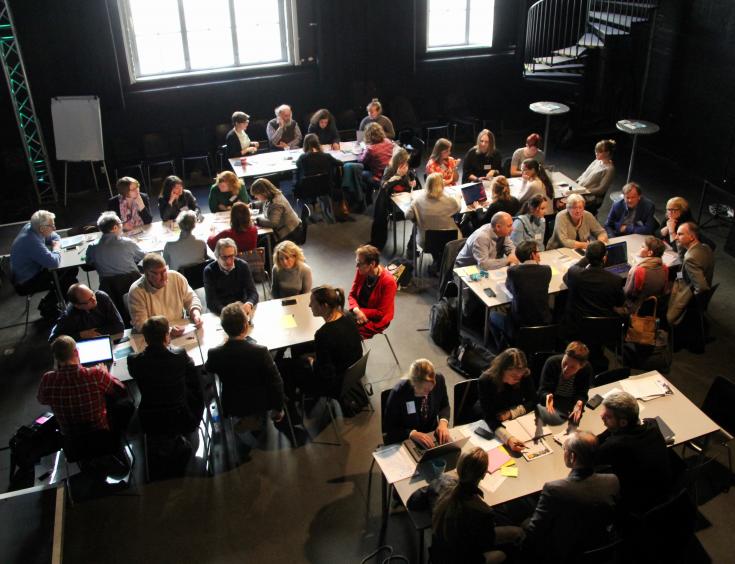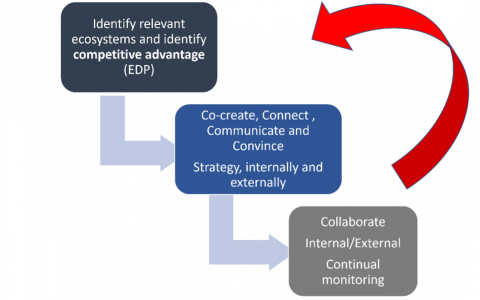EU industrial strategy: key learnings

The Policy Learning Platform organised an online discussion on EU Industrial Strategy on Thursday 16 December 2021. The online discussion explored the role of regions in the EU Industrial Strategy.
The session was moderated by our Thematic Experts in research and innovation, Arnault Morisson and Marc Pattinson. Alongside them, we had brilliant speakers: Richard Tuffs from Friends of Smart Specialisation, and Piotr Zajaczowski and Lucia Alfano from the European Committee of the Regions.
Key learnings
On 10 March 2020, the European Commission adopted the EU Industrial Strategy to lead the twin transitions towards climate neutrality and digital leadership. The EU Industrial Strategy outlines three drivers for industrial transformation: global competition, climate neutrality, and a digital future.
The strategy is underpinned by a set of inter-connected and reinforcing elements: (1) certainty for industry and a deeper and more digital single market, (2) upholding a global level playing field, (3) a shift to climate neutrality, (4) building a more circular economy, (5) embedding industrial innovation, (6) skilling and re-skilling, and (7) investment and financing the transition. Due to the COVID-19 crisis, the EU Industrial Strategy was updated to promote Europe’s recovery in May 2021.
The EU Industrial Strategy reflects on a new paradigm for the European Union, i.e. the European industrial sovereignty, namely in its strategic autonomy in key technologies and access to raw materials. To achieve this new paradigm for European strategic sovereignty, the European Commission will use different tools and initiatives such as:
- The framework for the screening of foreign direct investment to safeguard Europe's interests.
- The Important Projects of Common European Interest (IPCEI).
- An Action Plan on synergies between civil, defence and space industries.
- An Intellectual Property Action Plan to uphold technological sovereignty.
- A new EU pharmaceutical strategy in 2020.
- Further legislation and guidance on green public procurement.
- An Action Plan on Critical Raw Materials.
Smart Specialisation Strategy (S3) can play an important role to connect top-down directionality EU Industrial Strategy initiatives with bottom-up regional industrial ecosystems. This can be seen in the following illustration by Richard Tuffs, from Friends of Smart Specialisation (FoSS).

Figure 1. EU industrial strategy and regions - Source: Richard Tuffs, Friends of Smart Specialisation (FoSS)
The good practice strategic ecosystem development offers a tool for reshoring and identifying interregional complementarities. In INNO INDUSTRY, the good practice focuses on the method of value chain identification developed by the Latvia Ministry of Economy through a pilot project for "strategic ecosystem development".
The pilot project aims to strengthen triple helix collaboration, attracting public and private investments to promote innovation, and improving infrastructures and legislation. It has been conducted through a series of conferences, meetings, hackathons, and workshops, where key actors from academia, public and private sectors were called to identify ecosystem development potential and collaboration opportunities.
Three main value chains have been identified in the sectors of biomedicine, smart cities and smart material and analysed though an 8 step-method based on ecosystem approach. The organisations are addressed to a constructive self-analysis aimed to determine competitive advantages and identifying directions of future development. The ecosystem approach allows the identification of specific triple-helix stakeholders from industry, academia and public sector to be involved in the creation of a cross-sectoral cooperation platform to upgrade existing value chains. The good practice seemed highly relevant and the methodology transferable to other regional contexts.
Following the keynote presentation and the good practice presentation Piotr Zajaczkowski, Policy Officer at the European Committee of the Regions presented an update on the current policy debate within the CoR on the topic of industry strategy and the recent adoption of an opinion on this topic. This includes recommendations such as the need:
- To design an inclusive industrial strategy that creates value across European regions,
- To strengthen the regional ecosystem approach, so as to effectively involve key actors at local and regional level, such as governments, clusters and cluster organisations, and the social partners, as well as knowledge institutions (including universities of applied science with a strong link to SMEs).
The support for the digitalisation of SMEs is highlighted, a topic that has been developed in several other Policy Learning Platform documents and activities.
The CoR opinion also “reiterates its call to reinforce the place-based dimension in the Updated Industrial Strategy in order for regions and cities, as the governments closest to citizens and ecosystems, to take ownership of the green and digital twin transitions of their industry”.
The CoR will be present at the 2022 EU Industry Days and invited Interreg Europe project partners to join them.
Following the presentations and the intervention of the European Committee of the Regions participants engaged in a lively debate. Interesting themes included:
- The need to secure synergies between the 14 industrial priority sectors and regional policy, for example the new instrument 3I (interregional innovation investments) promoted by DG Regio and the need to engage with the S3 Partnerships or other pan European industrial cooperation;
- The development of new funding programmes within Horizon Europe such as the Pillar Three (European Innovation Council) and the support given to strengthening European Innovation Ecosystems can support sector based cooperation;
- The opportunity for regional authorities (via relevant Industry focused Interreg Europe projects) to participate in the Industry Forum.
Finally, it is worth noting that our latest policy brief on
Presentations
- Document
- Document
Policy Learning Platform resources
- Read the article on the European Green Deal and COVID-19, implications for research and innovation
- Read the article on the opportunities for the low carbon economy in the Covid-19 recovery plan
- Read the policy brief on Document
- Have a look at the online discussion on the European Value Chains (EVCs) towards greater European industrial sovereignty (presentation and insights here).
- More info on the 2022 EU Industry Days
- Good practice on the strategic ecosystem development
If you have any specific questions related to the EU Industrial Strategy, you can reach out to Policy Learning Platform experts directly via the policy helpdesk.
